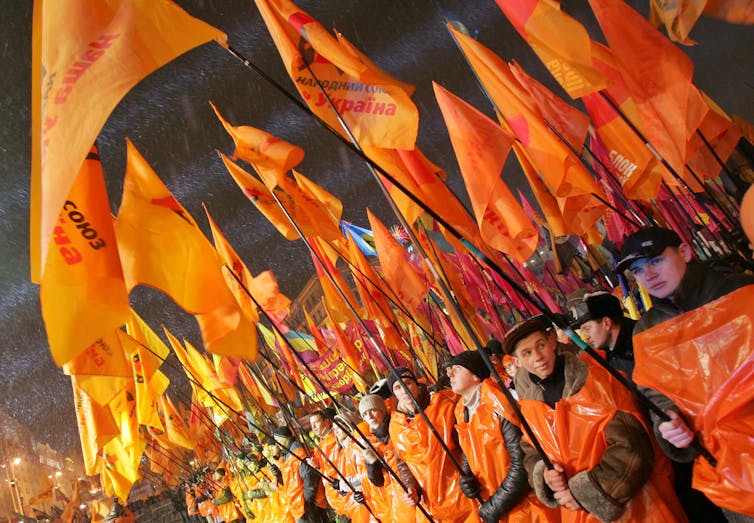
Ukrainians mark the first anniversary of the Orange Revolution in 2005.
REUTERS/Gleb Garanich
The term “colour revolution” has recently found its way into South Africa’s political vocabulary. The evocative phrase is increasingly cropping up in government and ruling party speeches.
African National Congress (ANC) Secrecy General Gwede Mantashe has, for instance, claimed that the party is under threat from a “colour revolution”. And in a recent speech David Mahlobo, former State Security Minister and now energy minister, argued that African countries are also under threat. He claimed that these “colour revolutions” were as a result of the
nefarious activities of rogue NGOs threatening national security.
It is easy to dismiss Mantashe’s and Mahlobo’s statements as the rantings of an increasingly paranoid ruling elite. But doing so would be a mistake. The “colour revolution” is a full blown intelligence doctrine - or a principle of intelligence policy - used by authoritarian or semi-authoritarian regimes to guide responses to protest movements. It is most closely associated with regimes in the former Soviet Union countries and the Balkans.
In South Africa, “colour revolution” talk is now being translated into deeds. In his recently released book, The President’s Keeper Jacques Pauw, the South African investigative journalist, claims that:
one of the ‘colour revolutions’ that the State Security Agency identified as promoting ‘regime change’ was the Fees Must Fall student protests’, and that these protests could lead to ‘an attempted coup d'état’.
Sources also told Pauw that the police recruited spies from within the movement to infiltrate student organisations.
The government’s appropriation of this doctrine strongly suggests that South Africa has been swapping notes with countries like Russia on how to contain popular dissent. And when legitimate organisations are treated as criminally suspect, democracy itself is threatened.
The Eurasian ‘colour contagion’
The fall of the Berlin Wall in 1989 spelled the end of authoritarian communism. More than a decade later a diverse series of pro-democracy protests broke out across the region. The first was the Rose revolution in Georgia in 2003. This was followed by the Ukrainian Orange revolution in 2004 and then the Tulip revolution in Kyrgyzstan in 2005.
The name “colour revolution” came from the fact that they had all adopted particular colours, or flowers, to represent their struggles.
The protest movements mainly used non-violent strategies, focusing on regime change through democratic elections. Some were true mass protests, while others were middle-class led, with significant student and NGO involvement.
Regimes used the term “colour revolution” to explain the contagion of the protests, which they said had spread because Western countries have sponsored them to ensure pro-Western regime change.
Some movements did receive Western sponsorship, and were undoubtedly tools of Western foreign policy. But to cast all the protesters as agents of foreign imperialists was both historically incorrect and politically dangerous. Many were legitimate anti-government campaigns taken up by disaffected social groups.
While the initial wave of protests were largely successful in removing authoritarian regimes, later ones were less so. This was mainly because governments had learned from one another about how to contain the protests.
By the time the Arab Spring swept across the Middle East and North Africa from 2010 to 2012, governments had fine-tuned a range of strategies to contain popular protests, building on those developed to contain Eurasia’s “colour contagion”.
From violent to ideological state strategies
Shaken by the “colour contagion” and fearing further diffusion, Eurasian regimes such as those in Russia, Azerbaijan, Belarus, and Iran studied the protests and collaborated to develop strategies to contain them.
Repression was always an option, but it wasn’t the preferred strategy because it could be politically damaging and possibly escalate the protests.
As a result the focus was on ideological strategies to prevent and respond to protests.
Across the region, protests were delegitimised and marginalised by linking them to the West. Conspiracy theories about the protests being foreign led were circulated. They were characterised as threats to sovereignty, territorial integrity and stability.
Regimes with strong economies used financial resources to secure the loyalty of local elites and co-opt sections of the protest movement. For example in Russia, fearing the rise of a colour revolution in 2007/2008 the regime set up an alternative, youth mass movement, which engaged in large counter-protests.
In Tajikstan and Belarus, the regimes used their control over resources to ensure the loyalty of local elites. In Uzbhekisatan, the regime was able to co-opt sections of the protest movement.
A convenient doctrine
By using the “colour revolution” doctrine, the ANC and the country’s security apparatus can stretch the definition of what constitutes a national security threat. Local NGO’s and protest movements engaging in lawful advocacy can now be accused of engaging in subversion, and investigated on these grounds.
Jane Duncan, Professor in the Department of Journalism, Film and Television, University of Johannesburg
This article was originally published on The Conversation.
No comments:
Post a Comment